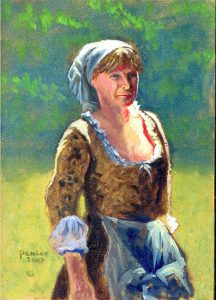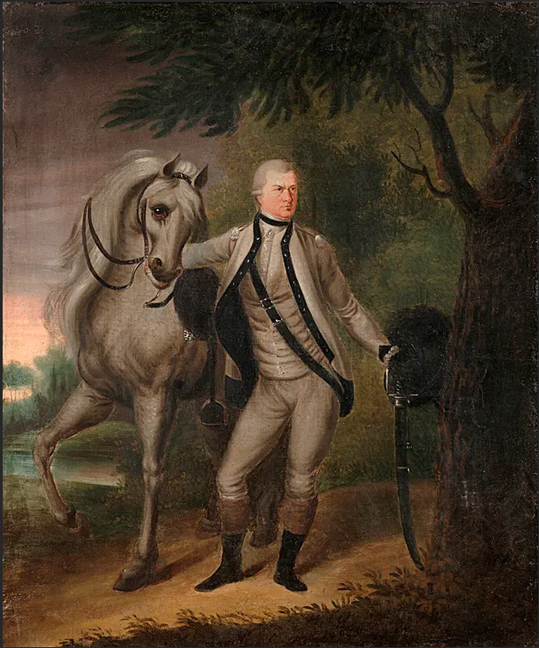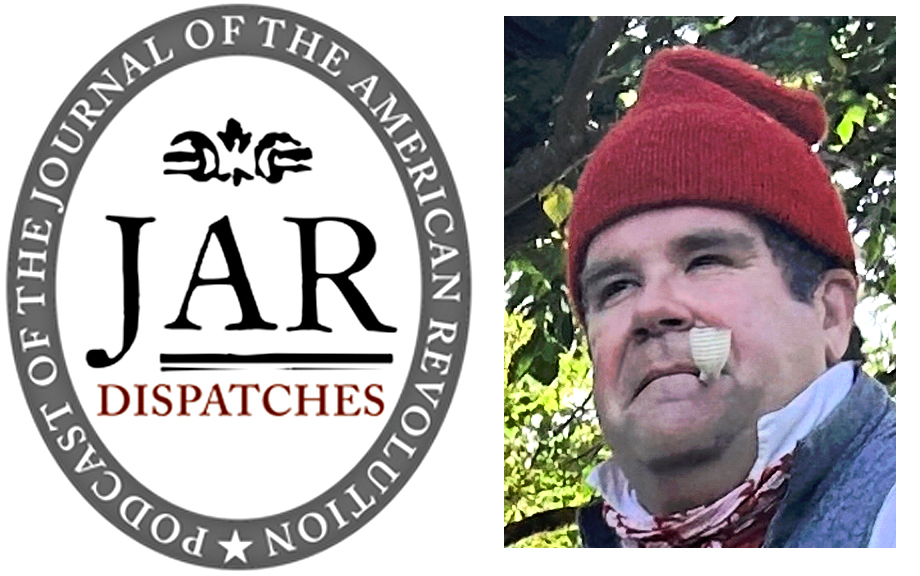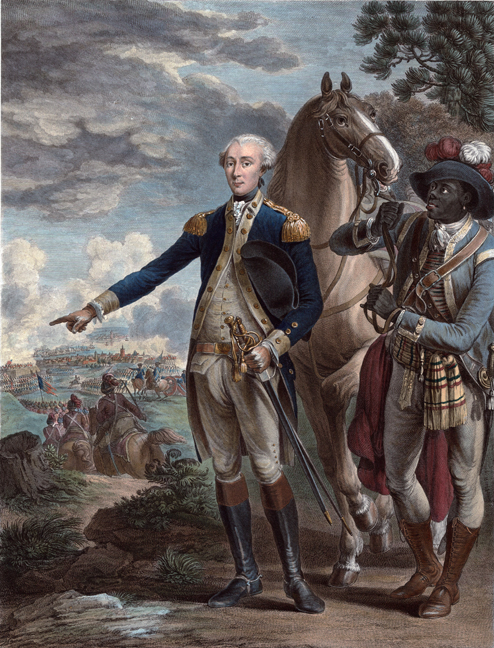To create an organized and effective force the Continental Army required more than just soldiers and officers. Camp followers helped to maintain and even provide supplies, and drummers were critical for signaling routines in camp and coordinating movements. In many cases the war would become a family affair, calling on men, women, adults, and children to all participate and assist in some capacity. In a society where men were typically the breadwinners of the household, husbands and fathers leaving to fight could leave the rest of the family in a difficult position. Staying at home might mean limited means and even facing violence from passing armies and neighbors with opposing sympathies. Whether supporting one side or just trying to survive, the cost of war would be inescapable for every member of a family and for many, sticking together and collectively supporting the cause seemed the best choice. Alexander Milliner was part of one such family and so would become entrenched in the war from an early age. Known at the time by his stepfather’s surname, Maroney, he was not only among the many young drummers in the Revolution but very likely also experienced life as a camp follower alongside his mother prior to enlisting.
There is some question as to the exact year of Milliner’s birth as two sources suggest two different dates ten years apart. His own pension application places it in 1770,[1] while a biography by Elias Brewster Hillard, based on an interview with him in 1864, claims he was born in 1760.[2] The 1770 date is more in line with the accounts of his life in both sources. Despite suggesting the earlier birth year, the Hillard account claims that Milliner was enlisted as a drummer because he was “too young at the time of his enlistment for service in the ranks.” Had he been born in 1760, this would have made him old enough in 1776 to serve as a soldier and somewhat old to be just starting out as a drummer. Recent research on Milliner reveals that he enlisted in 1780;[3] claiming his youth as a reason for becoming a drummer makes far more sense if he was born in 1770 and was therefore ten years old when he enlisted, giving him no other choice but to be a drummer or fifer.
Anecdotes about his experience and family history suggest that young Milliner may have been familiar with the integral, but often overlooked, part of military life even before becoming a drummer. His stepfather, Florence Maroney, had been a sergeant in the 1st New York Regiment since 1776, meaning that the war was a significant part of Milliner’s life from the age of six. And given some memories mentioned in his biography the boy seems to have been right in the midst of the action even then. While speaking with Hillard, Milliner mentioned that his mother had been accompanying the army as a washerwoman during his service. Although Hillard claims that she volunteered “for the sake of being near her boy,” she could easily have done so earlier for the sake of being near her husband. And if that were the case then, like many other camp followers she may have brought her young son along as well.[4] Not only was this a common and plausible choice for a woman facing the prospect of the head of the household leaving, for Mrs. Maroney the life of a camp follower was already familiar.

Hillard’s biography of Milliner states that following an army was what brought his mother, at the time Mrs. Milliner, to America during the French and Indian War. When Alexander’s father left England as a tradesman serving the British Army his wife joined him and would ultimately decide to remain and make a life for herself in the colonies after being widowed. This suggests she may already have been partial to remaining close to her family and comfortable in military life. Furthermore, given that her second husband, Florence Maroney, was a mason before he decided to join the fight for independence, choosing to follow him may have seemed the best way to ensure she and her six-year-old son would be provided for.[5] Although many wives did remain at home to keep farms and even some businesses going in their husband’s absence, many others felt their best chance was to follow their men in the army. Trades such as masonry would be different from a farm or shop where women might normally have participated heavily in the daily tasks even before the war. Even a woman as “high larnt” and intelligent as Milliner describes his mother[6] might have had difficulty immediately picking up the masonry business Maroney left behind. So it is reasonable that Mrs. Maroney, having already had experience as a camp follower, might have decided to take young Alexander and remain with Florence Maroney and the 1st New York either at the same time he enlisted in 1776 or soon after.
Although Milliner’s biography never directly mentions living as a camp follower, he does claim to have witnessed major events and battles that occurred prior to his enlistment. For example, he claimed not only to have been present but also wounded in the battle of Monmouth which occurred in 1778 when Milliner was eight years old, two years before he enlisted as a drummer. However it was after his stepfather began his service as a sergeant and it was a battle that the 1st New York participated in. If Mrs. Maroney became a washerwoman initially to be close to her husband then a young Milliner may well have been witness to battles that occurred before his own enlistment. In fact that may have been a factor in choosing to enlist at age ten, because he was already present in the regiment anyway it may have seemed a natural choice for him to enlist once he was old enough. Sergeant Maroney might have felt it wise to enlist his stepson as a drummer rather than leave him as a camp follower even longer, facing all the dangers of war without the recognition or payment of a soldier. And the lack of mention of being a camp follower in his biography does not necessarily go against this reasoning. To a young child, camp following and drumming may have largely felt as all one and the same, just learning new skills and getting additional chores as he grew older. And then for a man in his nineties reflecting on his life between the ages of six and thirteen, memories could easily have blurred together.
If the anecdote relating to the battle of Monmouth is accurate, eight-year-old Milliner did not restrict himself to staying away from the fighting. Whether by choice or simply due to the chaos of battle he found himself in the line of fire. He recounted receiving “a flesh wound in the thigh” during the battle. Unfortunately he offered little context as to what he was doing at the time or where he was in relation to the fighting. He does recall an officer stopping to ask what was wrong with him during the battle. Young Milliner, apparently not having noticed his wound, claimed nothing was wrong. It was only when the officer exclaimed “you are bleeding to death” that he realized “the blood was gushing out of me.”[7] Despite the apparent severity of the wound the elderly Milliner seemed to be no more concerned by the memory than he had been as a boy before the officer spoke to him. As any historian that has conducted oral history interviews likely knows, reminiscing can sometimes lead to tangents or wandering thoughts. And rather than focus on the wound, Milliner’s account progressed into his impressions of Gen. Charles Lee’s actions in the battle and the general’s strikingly large nose rather than mentioning what was done about his wound.[8]
This casual outlook on injury was by no means unheard of even for a young child, but rather speaks to just how involved the camp followers were in battles and the war itself. In fact Milliner was not the only eight-year-old to be caught in the crossfire of battle, nor to press on to other matters despite the injury. One year prior to Milliner receiving his battle wound another eight-year-old named Hugh Morrison accompanied his father, a surgeon, to Fort Montgomery, yet another example of families including young children in the war effort. The young boy was acting as his father’s waiter, helping to prepare bandages and other supplies to tend to injured soldiers. According to his pension application, young Hugh received “a deep incision” in his head, probably from a musket ball, during the attack on the fort, a wound which his father quickly bandaged before setting him back to work. Despite attesting to assisting the surgeon and having corroborating witnesses, the young Morrison’s application was denied because he was not officially a soldier.[9] Florence Maroney’s decision to enlist his stepson as a drummer spared Alexander Milliner from being denied a pension for the same reason.
In a time when children might help in simple household tasks as early as their toddler years it would only seem natural that children accompanying parents in the army would also assist in the necessary tasks. Milliner, like Morrison and many young camp followers, found himself in the heart of the action. And so it likely seemed natural for Milliner to be enlisted officially in some capacity once he was old enough to be accepted into some position, with musicians typically being younger than armed soldiers. This seemingly natural progression of responsibility likely contributed to the lack of distinction of timing in Milliner’s biography. In cases such as Monmouth it is easy to determine thanks to records that pinpoint the date of the battle and his enlistment. In other more private memories it can only be left to speculation.
While Milliner claimed to have memories of meeting both George and Martha Washington, whether his first impressions came as a soldier or as a boy in the camp is difficult to tell. There are enough specific details and direct references to suggest that Milliner did indeed have some interactions with them, rather than just repeating stories he heard from others, but the timing still remains uncertain in many stories he shared. Milliner recalls that Mrs. Washington often visited the hospitals, describing her as “kind-hearted” and having a “motherly care” towards soldiers under her husband’s command.[10] He may well have been in the hospitals at some time, either helping with simple tasks as any young camp follower might or being tended to himself. Or his impressions may have been a mixture of brief personal encounters and recollections of others that he heard later.
It does seem clear that Milliner had personal interaction with General Washington. He shared a story with his biographer about being called to Washington’s headquarters where he was told to play a tune on the drum and apparently did well enough that Washington gave him three dollars as a reward. He also seemed to have interacted with Washington on a fairly regular basis, recalling how the general would “come along and pat him on the head, and call him his boy” after Milliner played the reveille.[11] Given the references to music in both memories, these interactions happened over the “three years and six months” between his 1780 enlistment as a drummer and discharge at the end of the war.[12] Although it may never be known precisely when these interactions occurred or how much was accurate personal memories as opposed to hearsay, Milliner’s stories do provide meaningful insight to the lives of not just soldiers but the camp followers that played critical roles in keeping the army functioning.
Alexander Milliner’s experience in the Revolutionary War helps to reveal the many facets of and participants in military encampments. Having been among camp followers and having served as a drummer, he witnessed first-hand the army’s reliance on the civilians that joined them as well as the dangers they faced. He also provides an example of the role of family in the war, describing his mother’s choice to leave the comforts of home to stay near her loved ones and keep her family together, supported by Florence Maroney’s decision to enlist his stepson as soon as he was old enough to serve as a drummer. Milliner became one of the last surviving Revolutionary War veterans. E. B. Hillard’s account of his service, although imperfect in some regards as explained in Don N. Hagist’s book, still provides deep insights into the complexity of the revolution and the many different ways in which civilians and soldiers contributed to the cause.
[1]Pension deposition of Alexander Milliner (filed as Alexander Maroney, even though the name is spelled Marony in the deposition), S. 42,925, Revolutionary War Pensions, in Don N. Hagist, The Revolution’s Last Men: The Soldiers Behind the Photographs (Yardley, PA: Westholme Publishing, 2015), 104-106.
[2]E. B. Hillard, The Last Men of the Revolution, (Hartford: N. A. & R. A. Moore, 1864), chap. 4: Alexander Milliner, www.americanrevolution.org/last_men/lastmen4.php.
[3]Muster roll of Capt Nicholas Renselaer’s company, 1st New York Regiment, September-December 1780, in Hagist, The Revolution’s Last Men, 95.
[4]Hillard, The Last Men, chapter 4.
[9]“Pension Application for Hugh Morrison,” Revolutionary War Pensions: New York State Applicants, revwarny.com/morrisonhugh.html, accessed November 14, 2018.








One thought on “Alexander Milliner, Age Ten, Enlisted September 1780”
Thanks for this wonderful article bringing even more insight to the war. I really appreciate the way your story flowed and just wanted to say “thanks.”